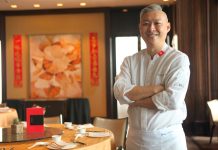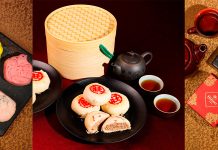Organic modern style combines the unfussy lines of contemporary design with the warmth, texture, and comfort of natural objects. Suave and down-to-earth, the look is intimate and attractive to people who seek structure and tradition.

façade. They bring in more light and allow more sweeping views of the landscape
Interior designer John Vigilia adopted this look for a residence owned by two doctors. His clients saw his condo project featured in a magazine, and liked what they saw. The unit was brightened up with a light color palette that brought out the textures of the organic elements, such as the natural wood finishes.
“If I can’t buy real wood because it’s beyond the budget, then I substitute finishes that mimic nature,” says Vigilia.
Built by architect Eugene Mangubat, the four-bedroom house in Quezon City has an open-plan living room with a high ceiling and an adjacent dining area. From the entrance, one is greeted by the openness and a succession of views from the living room to the lanai.
The modern, clean lines of the shell contrast with the wooden slats, made of composite engineered wood, in key areas of the house.

easy flow of movement and communication from area to area
Vigilia interprets the organic modern style of harmonizing natural materials, shiny and matte textures, and strong geometric lines. The structured major furniture pieces are complemented with a woven rug, throw pillows, and splashes of cinnamon against a neutral background, resulting in a consistent design.
The designer’s approach to the house is casual and unpretentious, where each piece of furniture or accessory is chosen for its uniqueness, value, and flexibility. He believes that modern organic pieces make lifestyle more natural, relaxing, and aesthetically pleasing.
Comfort is one of the key elements of this look, and also one of the principles that guide the style. The designer adds that organic modern décor is a bit tricky to describe, because it falls under the modern eclectic look.
To get the look, Vigilia applies his signature style of combining sculptural furniture pieces by local designers with straightforward foreign pieces. They are meticulously selected to keep the look up-to-date and uncluttered. “I didn’t put too much furniture and accessories. There’s a lot of space around them so you can appreciate each one,” says Vigilia.

that the living room is part of the environment. The use of a glass coffee table and the modern lighting
fixture provides a modest but modern and sophisticated flair; The dining room is a clean sweep of
curvaceous furniture and cinnamon dining chairs that offset the neutral color scheme
The core characteristic of his décor is the depth, created through the variety of tactile textures and forms. Making an impression on visitors, the foyer plays with the contrasting shapes and surfaces of designer Tata Montilla’s free-form oxide silver leaf installation over a rectangular mahogany console table.
In the living room, industrial designer Kenneth Cobonpue’s organic Lulu buri accent chairs and Chiquita stools and woven abaca rug complement Bo Concept’s angular coffee table and rectangular sofa. Cobonpue’s paper pendant light creates a moonlight effect at night.
A focal point in the dining area, Cobonpue’s sculptural Wave table, made of wooden slats, mimics the ocean waves. Vigilia leaves its glass top unadorned to show its natural beauty. “Other decorations will merely be a distraction,” he says.
The soft curves in the dining room are also echoed in the metal console table by export company Industria, and Philippe Starck’s suspended KTribe pendant light. “All the elements just flow yet they look very modern,” says Vigilia.
The dining room likewise opens to the view of the lanai, which is yet again a happy contrast of textures—porcelain tiles, a fabric sofa with a metal and wood artwork, a coffee table with a thick solid marble top, and a glass-topped mahogany dining table. The foliage has been cultivated to produce different shades of green.
Instead of a flat assortment of furniture and lighting, Vigilia creates an inviting space that allows the visitor or inhabitant to look around, linger, and appreciate the aesthetic of the pieces.
Only two years as a solo interior designer, Vigilia has been noticed by glossy magazines as an emerging talent. Moreover, he’s been getting projects for a big-time developer, offices, and well-to-do clients.

combination of furniture and accessories in the master and children’s bedroom is much less centered on
having particular articles than on producing a cozy feel
After graduating from accounting, he worked in an office and realized it wasn’t for him. Following his creative instincts, he enrolled at the University of the Philippines’ interior design program on condition from his parents that he pay for his own tuition. Vigilia took odd jobs to finance his course.
The efforts paid off. He worked for the prestigious firm Budji + Royal Architecture + Design for six years. Vigilia credits design consultant Antonio “Budji” Layug and architect Royal Pineda for imparting to him the integrated approach to design. “Budji exposed me to the importance of harmony between architecture, interiors, and landscape. Since I’m a plant lover, it was easy to pick up from Budji,” says Vigilia.
In 2015, Vigilia started his eponymous firm and a furniture company, FinoPino. He attributes his steady stream of work to his flexibility. Clients from residential projects end up commissioning him for their offices. “I’m easy to deal with. I don’t act arrogant and I deliver on time,” he says.
Phorogaphs by Paul San Juan
See more of John Vigilia’s clean contemporary designs on Asian Dragon Magazine’s October-November 2016 issue, available for download on Magzter.






































